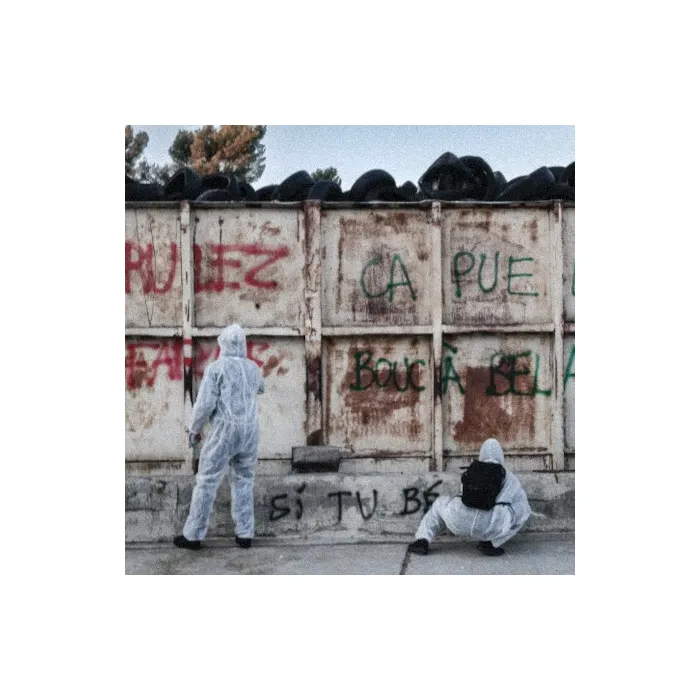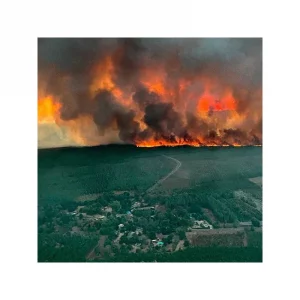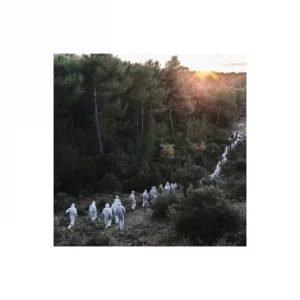from Inhabit: Territories

As is well-known, the rising tide of struggle against global warming responds in many cases to literal rising tides. The resulting horror for many people—especially in the global south—is that there will be too much water for life to go on living. As the surface of the earth warms and the arctic begins to see rain rather than snow, the oceans threaten to swallow whole islands, whole regions, whole coasts. For others, the problem is quite the opposite: wildfires, severe droughts, creeping deserts, and massive species-extinction. Although located in a “safer,” more temperate zone in the European center, France nonetheless belongs to the latter group. The last few years have seen a terrible drought, so bad at times that wildfires rage across the southwest and nuclear power plants must be shut down for want of water with which to cool the reactors.

Wildfires rage across Gironde area of southwestern France in early August 2022
This drought has been especially difficult for French farmers, who struggle to maintain sustainable crop yields in the absence of rain. In response, the French state has imposed broad restrictions on water use and begun to construct a series of mega-basins, enormous artificial reservoirs designed to draw the region’s groundwater to the surface and make it available during the hot summer months.
In its natural state, groundwater functions as a sort of subterranean agricultural commons, protected from solar evaporation and, at least in part, from different kinds of industrial or atmospheric pollution, such as runoff from factories or the life-cycle of other organisms (like insects or animals). Once drawn to the surface and encased in concrete, the water changes shape entirely, becoming a “resource” to be allocated according to the ends and interests of the state and its partners. When the state proposed the construction of sixteen more of these basins in 2017 in the Deux-Sèvres department, they offered 60 million Euros of government money to pay for the project, and promised the en-basined water to a specific cooperative of over 200 farmers known as Water Coop 79. While restrictions on water usage extend to everyone, only those who partner with the state have access to the mega-basin reserves, transforming the groundwater from a vital commons serving all life and even the land itself into another kind of private property.
This expropriation of the groundwater is by no means necessary or permanent, as the actions described below demonstrate quite clearly. The first action described, which occurred just ten days ago, attacked and sabotaged the Lafarge Cement Factory, where the cement needed to construct these mega-basins is produced. The second, the massive rally against the construction of the mega-basin Saint-Soline back in August, brought together a thousands of different people and a coalition of organizations to bring work to a halt for over a week. Both actions not only interrupt the expropriation of the water commons or the cement production essential to agribusiness but introduce a whole different horizon of a life lived in common with all living things, from the wetlands of France’s Green Venice to the bustard flying over small farmers’ fields of rapeseed. Les Soulevements des Terres describe this horizon in the final lines of their website:
We are young rebels who have grown up with the ecological disaster in the background and precariousness as our only horizon. We fought against the labor law, police violence, racism, sexism and the climate apocalypse.
We are inhabitants in struggle attached to their territory. From legal recourse to direct action, we have achieved local victories. Faced with the concrete builders, our resistance is multiplying everywhere.
We are farmers. There are almost no more in France. We strive to establish a relationship of daily care to the earth and to the living to feed our fellow creatures.
We are: you, me, us. All those who feel isolated and powerless in the face of the atomization of struggles, the difficulties of acting, and the voracity of the owners. Those who were waiting to be more numerous to fight: here is an opportunity to join our actions and our reflections, this is the moment!
Like the Zapatistas fighting for the right to a life lived in common and a world in which many worlds fit, like our indigenous comrades fighting the construction of pipelines across their reservations and burial grounds, like our friends sitting in trees and fighting charges of “domestic terrorism” in the Atlanta forest, like the joyous masses who burned down the Third Precinct during the George Floyd Rebellion, we, too, are part of these uprisings of the earth. And so we hope you’ll read these pieces as the invitations that they are, to join in the uprising and fight for a horizon of life that sacrifices no one.

On December 10, 2022 at 6pm, 200 people invaded the Lafarge plant of La Malle in the city of Bouc-Bel-Air, taking the plant by surprise and disarming it. With a determined and joyful atmosphere, the infrastructure of the plant was attacked through any and all means: incinerator and electrical devices sabotaged, cables severed, bags of cement eviscerated, vehicles and construction equipment damaged, office windows ruined, and walls repainted with tags.
Lafarge-Holcim is one of the largest polluters and CO2 producers in the country. Targeted by several anti-terrorist legal proceedings, the multinational corporation systematically stifles any attacks against it. Here in Bouc-Bel-Air, the furnaces we’ve targeted, long fueled by tires and other industrial waste, are now a symbol of greenwashing. Though the atmospheric pollution is considerable and has been denounced time and again by the press and by local residents, the chimneys still spew their poison.
For three years, more and more determined actions have targeted Lafarge-Holcim in France and in Switzerland. First, there were the “Fin de Chantiers” blockades in 2020, followed by the simultaneous occupation and sabotage of four sites by hundreds of people in June 2021 during the “Grand Péril Express” operation, and finally successive mobilizations against the destruction of the Saint-Colomban bocage by Lafarge in the Loire-Atlantique region of France and the Zad de la Colline against an extension of Lafarge’s quarry in Switzerland.
After the bitter failure of the COP27, a failure easily foreseeable in the current COP15 in Montreal, we didn’t want to wait for a COP 2050 and another three degrees, so we returned today aiming at giving ourselves right now the means to stop these construction industries that destroy the earth.
Lafarge and its accomplices hear nothing of the anger of the generations they leave without a future, in a world ravaged by their misdeeds. Their machines, silos and concrete mixers are weapons that kill us. They will not stop unless we force them to. So we will continue to dismantle the infrastructure of disaster ourselves. We call on all those who stand up for the earth to occupy, blockade, and disarm concrete.
Why target Lafarge?
In its delirious race for profit, the Lafarge-Holcim group, along with its billions in revenue, refuses to back down, in disregard of all the ecological and social consequences it generates. Prosecuted in several countries, Lafarge and its leadership have demonstrated their cynicism through their involvement in financing the Islamic State in Syria. Sentenced by the United States in October 2022, and fined to the tune of 778 million dollars for supporting Daesh, they are still under investigation in France for complicity in crimes against humanity. The succession of tactical choices made by the French state, seen in exchanges between the DGSE and Lafarge, demonstrates one time too many that the proper functioning of capitalism requires that the state and industry work together.
Extracting rock under the protection of the State, even if it means feeding the war. Selling cement to rebuild what the wars have demolished. And in the process, destroying our living conditions and our environments to build a world of concrete and death, whether through greenwashing based on carbon neutrality or low-carbon cements produced by incinerating waste.
From the extraction of sand, to the production of cement and concrete, and to the massive, useless projects it facilitates, the entire complex of the construction industry represents an ecological catastrophe. From its supply chain to its application, the construction sector is responsible for 39% of CO2 emissions worldwide.
Here in Bouc-Bel-Air, Lafarge has never hesitated in lobbying for an allowance to exceed the environmental standards for dust and sulfur oxides set by the European Union. Of the fifty most polluting sites in France, twenty are cement plants, including this one, which produces more than 444,464 tons of CO2 per year, and feeds its kilns with thousands of old tires and all sorts of other toxic waste.
Within our landscapes as well as our imaginations, concrete has become the norm under the pressure of the industry’s lobbying and the complicity of public authorities. It is at the heart of the most absurd projects of the last decade: the construction of the Greater Paris Express and the 2024 Olympic Games sites, the attempted airport at Notre-Dames-des-Landes, the extension of the Château-Gontier quarry in Mayenne, or a few kilometers from here, the paving over of agricultural land in Pertuis….
Since power tightens its grip on its resources and its massive projects, even inventing the term eco-terrorism to legitimize its tracking of environmental activists, since today nothing seems to stop them, we will stop them ourselves. Discovering an adequate means to put an end to the ecocidal projects of land development, and destroying the infrastructure that makes them possible, are the only options to make the world desirable once again.
We do not want colonial eco-capitalism, a war-time economy, or a cynical and manipulative ecological transition. This is why we attacked Lafarge-Holcim today.
Bouc-Bel-Air, December 10 2022
Originally published in lundi matin
There has been a great deal of discussion in France about this demo against the mega-basins in Saint-Soline from October 29 and 30, and for good reason. The diverse and energetic crowd routed over 1700 police officers and six helicopters, much to the ire of the Minister of the Interior, among others. We feel this moment has as much to teach us as it did our friends in France, and we are therefore happy to bring you these lessons those involved published two weeks after the action. It offers lessons of great importance to those struggling against the end of the world everywhere.
“I was thinking again last night that I was missing something to take out the garbage.”
– Anemone, actress and temporary resident of St. Soline
Two weeks have already passed since the demonstration on the red lands of Sainte-Soline against the construction of the second mega-basin in Deux Sèvres. Marked by such enthusiasm that we have yet to wrap our minds around it, the demo continues to command both media and political attention. But after this period of forced work stoppage, the government has opted to resume construction and promised to build thirty new basins in the neighboring department.
The next national date of action will be announced this Thursday. These actions will aim to have a more lasting impact on these projects, putting them to a definitive end.
While waiting to organize ourselves accordingly, we want to share some considerations on the lessons to be learned from the October 29 demonstration, based on the path we have taken over the past year with the movement. We want to believe there is something to be learned from this experience that is more tangible than the projections emitted by the crowd of parachuting experts who lined up to speak to the media afterwards.
What we seek to explore here revolves around the following two hypotheses:
Starting from a given region and a relatively new form of infrastructure, which its promoters plan to spread everywhere, it is possible to unravel the knot tying together water monopolization, the maintenance of the agro-industrial complex, and the current unwavering support offered to it by the State. Therefore, there are two opposing horizons for the concerned territories, with a barricade between them, the two sides of which continue to be clarified, and some possible turning points in the face of the climate crisis.
More than an action of ecological resistance that suddenly increases the balance of power in a specific struggle, the action in Sainte-Soline engages in the necessary reconfiguration of the political field. Its offensive texture—comprised of teenagers grown up in a shipwrecked world and of lovers of the little bustard, of debaucherous rioters and retired people whose age has rendered them all the more diehard, of trade-unionists rediscovering their taste for sabotage and elected representatives, for once acting courageously. This breadth of the struggle gives a glimpse of what moments of climatic revolt could be, of the way they should take shape everywhere from now on in response to the absolute emergencies of the time.
[read the rest on the website]
